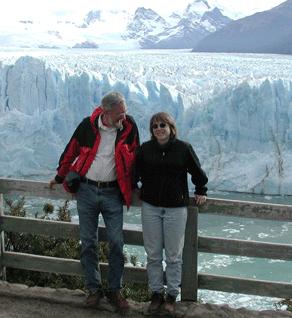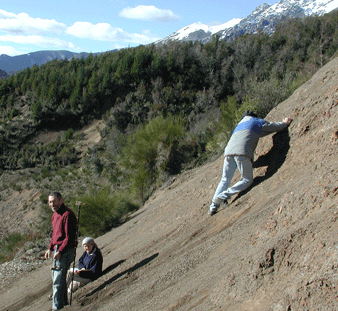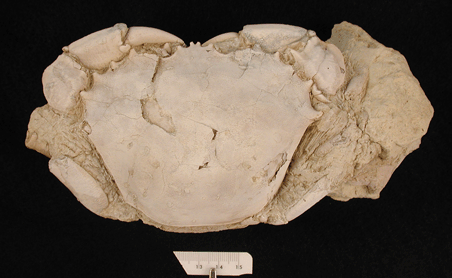
National Science Foundation Grant OPP 9909184, Collaborative Research: Paleoceanography of Eocene decapod-rich rocks in Antarctica and Southern South America, 1999-2005, Rodney M. Feldmann and Karen Bice |
|
back to Grants homepage
Publications |
Antarctic Decapod Data |
2004-2005 New Zealand Field Season |
2005 Argentina Field Season |
Goals of GrantThe purposes of the grant include refinement of the age of Eocene decapod-bearing rocks on Seymour Island, Antarctica, and in Patagonia as well as the establishment of temperature estimates, based upon oxygen and carbon isotopic analyses. The ultimate goal is to provide the basis for refined modeling of ocean circulation patterns by my collaborating PI, Karen Bice. The field work on Seymour Island has provided a detailed analysis of the occurrence of the fossil crabs (Feldmann et al., 2003) and remarkable preservation of fossil worms from Antarctica has been recorded (Schweitzer et al., 2005). Stable isotope analyses are being completed by Dr. K. C. Lohmann, University of Michigan. The preliminary results from Patagonia have revealed a vastly more complex set of problems than originally envisioned. |
 Rod Feldmann and Carrie Schweitzer, at Moreno Glacier, near El Calafate, Argentina (2003) |
 Silvio Casadío, Ana Parras, & Juan Pedro near Bariloche, Patagonia (2002) |
The basis for selection of collecting sites in Patagonia was drawn from earlier work that documented a putative Eocene decapod fauna from the so-called "Patagoniano" sequence in the vicinity of Calafate, southwestern Argentina. A prominent tuff layer occurs in the same sequence as the crabs and an age of 45.8±2 Ma (middle Eocene) was determined for the tuff using the 40Ar/39Ar method (Casadío, Feldmann, and Foland, 2000). However, strontium, oxygen, and carbon isotopic analyses on shell material from the giant oyster Crassostrea? hatcheri Ortmann yielded and age of 22 MA and indicated a seasonal temperature range from 15o to 21oC (Casadío et al., 2000). The oysters were associated with a fully marine assemblage of fossils. Subsequent field work in Patagonia, in collaboration with Dr. Silvio Casadío, Universidad Nacional de La Pampa, resulted in collection of decapod faunas in several localities in Santa Cruz Province. Two of these localities, La Siberia and Cabo Curioso, also were associated with tuff deposits. La Siberia is about 150 km north from Calafate and Cabo Curioso is on the Atlantic coast about 350 km east from Calafate. |
| It was hypothesized that the ages
of these tuffs would be similar to, or the same as, the age of the Calafate
tuff. They were not. The tuff sample from Cabo Curioso yielded an age of
84±27 (!) Ma possibly because the material was reworked. The tuff from La
Siberia yielded an age of 20.5±0.3 Ma, placing it in the Miocene. Age
determinations based upon 87Sr/86Sr analyses on the oysters from La Siberia
also yielded Miocene ages.
To begin to resolve these apparent age discrepancies, a second tuff sample from Calafate was run at a different lab. That run yielded an age of 64.8±1.6 Ma! Thus, rocks that were originally thought to be Eocene in age have now yielded widely different ages, a problem that may well stem from having made age determinations on two types of material, tuff and oyster shell, and using two very different techniques. |
 Chaceon peruvianus from the Miocene of Peninsula Valdes Chubut Province, Argentina |
| The decapod crustacean faunas collected from these various sites have species in common, including Chaceon peruvianus (d'Orbigny) and Proterocarcinus latus (Glaessner) (Schweitzer and Feldmann, 2000). The assemblage of decapods from the "Patagoniano" is similar throughout its geographic range and is comparable to Eocene assemblages throughout the western hemisphere. Recent collecting in the vicinity of Bariloche (Casadío et al., in press), about 1000 km north from Calafate, and on Peninsula Valdez (Casadío et al, in preparation), about 1100 km northeast from Calafate, has also yielded similar decapods. Thus, a decapod assemblage of "Eocene aspect" extends over a vast region in Patagonia in a sequence of rocks that have been variously dated as everything from Cretaceous to Miocene. These problems will be resolved within the duration of the grant as the isotopic work is concluded. | |
|
Undergraduate Brian Kelley collects fossils in New Zealand, funded by a supplement to this grant. Photo by R. Feldmann.back to top |
A supplement to this grant funded undergraduate student Brian Kelley's field work in New Zealand in December and January of 2004-05. This work will add to the Miocene and Pliocene record of decapod crustaceans in the Southern Hemisphere and will complement the work already done in Antarctica and South America. Brian's work will form his undergraduate Honors Thesis. Systematic, paleobiogeographic, and paleoecological advances will all result from this work. |
Casadío, S., R. M. Feldmann, and K. A. Foland. 2000. 40Ar/39Ar age and oxygen isotope temperature of the Centinela Formation, southwestern Argentina: An Eocene age for crustacean-rich "Patagonian" beds. Journal of South American Earth Sciences, 13:123-132.
Feldmann, R. M., C. E. Schweitzer, and S. A. Marenssi. 2003. Decapod crustaceans from the Eocene La Meseta Formation, Seymour Island, Antarctica: a model for preservation of decapods. Journal of the Geological Society, London, 160:151-160.
Casadío, S., A. De Angeli, R. M. Feldmann, A. Garassino, J. L. Hetler, A. Parras, and C. E. Schweitzer. 2004. New decapod crustaceans (Thalassinidea, Brachyura) from the late Oligocene of Patagonia, Argentina. Annals of Carnegie Museum, 73: 25-47.
Schweitzer, C. E., R. M. Feldmann, S. Marenssi, and D. A. Waugh. 2005. Remarkably preserved annelid worms from the La Meseta Formation (Eocene), Seymour Island, Antarctica. Palaeontology, 48: 1-13.
Schweitzer, C. E., and Feldmann, R. M. 2005. Decapod crustaceans, the K/P event, and Palaeocene recovery. In S. Koenemann and R. A. Jenner, eds., Crustacea and Arthropod Relationships, Taylor & Francis, Boca Raton, Florida, p. 17-53.
Casadío, S., R. M. Feldmann, A. Parras, and C. E. Schweitzer. 2005. Miocene fossil Decapoda (Crustacea: Brachyura) from Patagonia, Argentina, and their paleoecological setting. Annals of Carnegie Museum, 74: 151-188.
Feldmann, R. M., and C. E. Schweitzer. 2006. Paleobiogeography of Southern Hemisphere decapod Crustacea. Journal of Paleontology, 80: 83-103.
Feldmann, R. M., and S. Rust. 2006. Palaega kakatahi n. sp.: the first record of a marine fossil isopod from the Pliocene of New Zealand. New Zealand Journal of Geology and Geophysics, v. 49, p. 411-415.
Feldmann, R. M., C. E. Schweitzer, and D. McLauchlan. 2006. Additions to the records for decapod Crustacea from Motunau and Glenafric beaches, North Canterbury, New Zealand. New Zealand Journal of Geology and Geophysics, v. 49, p. 417-427.Feldmann, R. M., C. E. Schweitzer, P. A. Maxwell, and B. M. Kelley. 2008. Fossil isopod and decapod crustaceans from the Kowai Formation (Pliocene) near Makikihi, South Canterbury, New Zealand. New Zealand Journal of Geology and Geophysics, 51: 43-58. Undergraduate Student Involvement
Parras, A., M. Griffin, R. Feldmann, S. Casadío, C. Schweitzer, and S. Marenssi. 2008. Correlation of marine beds based on Sr- and Ar-date determinations and faunal affinities across the Paleogene/Neogene boundary in southern Patagonia, Argentina. Journal of South American Earth Sciences, 26: 204-216.
Crawford, R. S., S. Casadío, R. M. Feldmann, M. Griffin, A. Parras, and C. E. Schweitzer. 2008. Mass mortality of fossil decapods within the Monte León Formation (early Miocene), southern Argentina: Victims of Andean volcanism. Annals of Carnegie Museum, 77: 259-288.
back to top
Casadío, S., G. Guerstein, S. Marenssi, S. Santillana, R. M. Feldmann, A. Parras, and C. Montalvo. 2000. Evidencias para una edad oligocena de la Formación Centinela, suroeste de Santa Cruz, Argentina. Resúmenes de la Reunión Anual de Comunicaciones de la APA, Ameghiniana, 37(4):71R.
Marenssi, S., R. M. Feldmann, and C. E. Schweitzer. 2001. Distribution of fossil decapod crustaceans from the La Meseta Formation (Eocene) on Seymour Island, Antarctica: Changing times, changing patterns. Geological Society of America, Abstracts with Programs, 33(6):A-378.
Feldmann, R. M., and C. E. Schweitzer. 2001. Remarkable preservation of fossil worms (Annelida: Polychaeta) from the La Meseta Formation (Eocene), Seymour Island, Antarctica. Geological Society of America, Abstracts with Programs, 33(6):A-379.
Parras, A., S. Casadío, R. Feldmann, and C. Schweitzer. 2003. Análisis tafonómico e interpretación paleoambiental de concentraciones dominadas por ostras y cangrejos en la Formación Puerto Madryn (Mioceno superior), Patagonia, Argentina. Argentinian Paleontological Association, Symposium on Taphonomy, Santa Rosa, Argentina.
Parras, A., Casadío, S. Feldmann, R. M., Griffin, M., and Schweitzer, C. E. 2004. Age and paleogeography of the marine transgressions at the Paleogene-Neogene boundary in Patagonia, southern Argentina. Geological Society of America, Abstracts with program v.36, no. 5, p. 364.
Casadío, S., R. S. Crawford, R. M. Feldmann, M. Griffin, A. Parras, and C. E. Schweitzer. 2005. Paleobiological and taphonomic study of two Miocene South Atlantic shelf bottom communities dominated by crabs. Geological Society of America 2005 Annual Meeting Abstracts with Programs, 37(7): 404-405.
Crawford, R. S., S. Casadio, R. M. Feldmann, M. Griffin, A. Parras, and C. E. Schweitzer. 2006. Marine record of an early Miocene catastrophic event, Monte Leon Formation, Patagonia, Argentina. Geological Society of America 2006 Abstracts with Programs North Central Section, 38(4): 56.
back to top